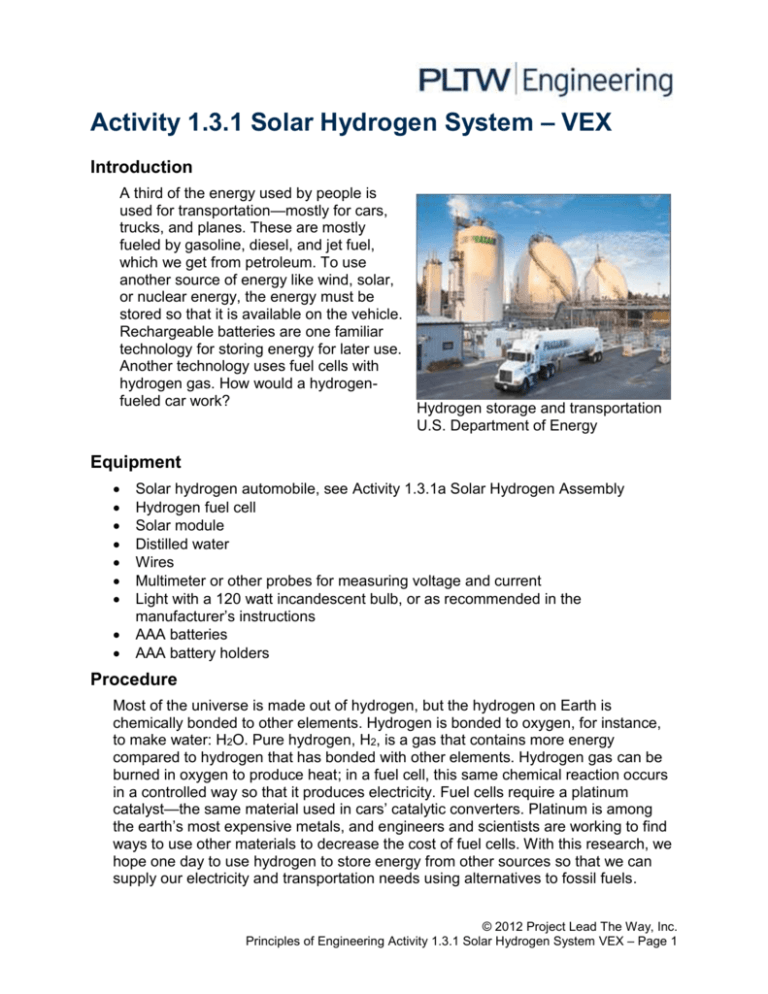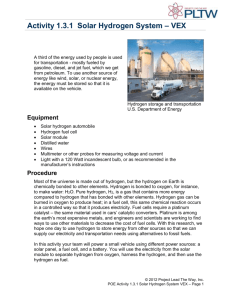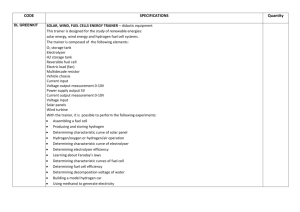Solar Hydrogen System Activity - VEX Robotics
advertisement

Activity 1.3.1 Solar Hydrogen System – VEX Introduction A third of the energy used by people is used for transportation—mostly for cars, trucks, and planes. These are mostly fueled by gasoline, diesel, and jet fuel, which we get from petroleum. To use another source of energy like wind, solar, or nuclear energy, the energy must be stored so that it is available on the vehicle. Rechargeable batteries are one familiar technology for storing energy for later use. Another technology uses fuel cells with hydrogen gas. How would a hydrogenfueled car work? Hydrogen storage and transportation U.S. Department of Energy Equipment Solar hydrogen automobile, see Activity 1.3.1a Solar Hydrogen Assembly Hydrogen fuel cell Solar module Distilled water Wires Multimeter or other probes for measuring voltage and current Light with a 120 watt incandescent bulb, or as recommended in the manufacturer’s instructions AAA batteries AAA battery holders Procedure Most of the universe is made out of hydrogen, but the hydrogen on Earth is chemically bonded to other elements. Hydrogen is bonded to oxygen, for instance, to make water: H2O. Pure hydrogen, H2, is a gas that contains more energy compared to hydrogen that has bonded with other elements. Hydrogen gas can be burned in oxygen to produce heat; in a fuel cell, this same chemical reaction occurs in a controlled way so that it produces electricity. Fuel cells require a platinum catalyst—the same material used in cars’ catalytic converters. Platinum is among the earth’s most expensive metals, and engineers and scientists are working to find ways to use other materials to decrease the cost of fuel cells. With this research, we hope one day to use hydrogen to store energy from other sources so that we can supply our electricity and transportation needs using alternatives to fossil fuels. © 2012 Project Lead The Way, Inc. Principles of Engineering Activity 1.3.1 Solar Hydrogen System VEX – Page 1 In this activity your team will power a small vehicle using different types of power sources: a solar panel, a fuel cell, and a battery. You will use the electricity from the solar module to separate hydrogen from oxygen, harness the hydrogen, and then use the hydrogen as fuel. This activity was written to be used with the Heliocentris fuel cell. If you are using the fuel cells from a different manufacturer, refer to that manufacturer’s instructions to be sure that the equipment is used as designed. 1. Read the Fuel Cell User Guide. 2. Follow the directions in the Fuel Cell User Guide under the section “Preparing the Fuel Cell for Use.” 3. Shine a bright light source on the solar panel, always keeping at least 8 inches of separation between the two to avoid melting the solar module plastic. Set your multimeter to measure voltage and connect the multimeter test leads to the solar panel terminals. Move the solar panel or light source to determine the location that produces the highest voltage value. You may want to mark the positions with some tape. Record the open-circuit voltage. Note the current is zero, since a voltmeter has nearly infinite resistance. VOC = Open-Circuit Voltage __________ Power = VOC x 0 A = 0 W 4. With the test leads disconnected, set your multimeter to measure current. Return the solar module to the same exact position that produced the highest voltage value and measure the current. Record this shortcircuit current. Note that the voltage is zero, since an ammeter has nearly zero resistance. ISC = Short-Circuit Current __________ Power = 0 V x ISC = 0 W © 2012 Project Lead The Way, Inc. Principles of Engineering Activity 1.3.1 Solar Hydrogen System VEX – Page 2 5. Calculate the amount of power that would be produced by the solar module if it could simultaneously produce the voltage and current you measured in the previous two steps. Power = Voltage x Current but they have to be occurring at the same time! For this illumination level, the solar module will deliver, at most, about 70% of this theoretical maximum, and will do so at a resistance between zero and infinite resistance. Maximum Theoretical Power = VOC x ISC = _________ 6. Attach the solar panel to the solar hydrogen automobile. Using a standoff or another suitable method, prop up one end of the chassis so that the motor-driven wheel is not in contact with the ground. Connect the motor leads to the solar module using the breadboard to make the connections. Position the light source to produce maximum voltage leaving a minimum distance of 8 inches between solar module and the lamp. Is there enough power to turn the motor? If so, is there enough power to turn the motor with the wheels on the ground? _________ 7. Set your multimeter to measure voltage. Connect the multimeter test leads to the solar module terminals. Record the load voltage value.(Drive gear should be engaged) V = Load Voltage __________ 8. Disconnect the test leads and set your multimeter to measure current. Connect the multimeter in series with the solar module. Record the load current. I = Load Current = __________ © 2012 Project Lead The Way, Inc. Principles of Engineering Activity 1.3.1 Solar Hydrogen System VEX – Page 3 9. Calculate the power delivered by the solar module when it is loaded by the motor with the wheels off the ground. P = Load Power = I V = __________ for solar module. 10. Energize the fuel cell by using one of the power sources according to the directions in the Fuel Cell User Guide under the section “Powering the Fuel Cell (Electrolysis)”. Fuel cells can be damaged by high current. If using a DC power supply with the Heliocentris fuel cell, do not use more than 500 mA. Do not use a battery to energize the fuel cell. 11. After the fuel cell is energized, attach the fuel cell to the motor using the breadboard to make the connections. Is there enough power to turn the motor? If so, is there enough power to turn the motor with the wheels on the ground? ______ 12. With the test leads disconnected, set the multimeter to measure voltage. Connect the multimeter test leads to the fuel cell terminals. Record the voltage value. V = Load Voltage __________ 13. With the test leads disconnected, set the multimeter to measure 10 A current, using the 10 A meter receptacle. Connect the test leads in series with the fuel cell. Caution! Never measure current from the fuel cell without a resistor, motor, or other load in series with the ammeter. Doing so can permanently damage the fuel cell. Record the current value. Load Current = __________ © 2012 Project Lead The Way, Inc. Principles of Engineering Activity 1.3.1 Solar Hydrogen System VEX – Page 4 14. Calculate the power delivered by the fuel cell. Power = Voltage x Current P = Load Power = I V = __________ for fuel cell. 15. Remove the fuel cell and solar module and attach the two AAA battery holders to your vehicle using zip ties. Using the breadboard, connect the batteries in series with each other and with the motor. (See next step for wiring hints.) Is there enough power to turn the motor? If so, is there enough power to turn the motor with the wheels on the ground? ______ 16. With the test leads disconnected, set the multimeter to measure voltage. Connect the multimeter test leads to the motor terminals. Record the voltage value. V = Load Voltage __________ 17. With the test leads disconnected, set the multimeter to measure 10 A current, using the 10 A meter receptacle. Connect the test leads in series with the motor terminals. Record the current value. Load Current = __________ 18. Calculate the power delivered by the batteries in series. P = Load Power = I V = __________ for batteries in series © 2012 Project Lead The Way, Inc. Principles of Engineering Activity 1.3.1 Solar Hydrogen System VEX – Page 5 19. Using the breadboard, connect the batteries in parallel with each other and with the motor. Is there enough power to turn the motor? If so, is there enough power to turn the motor with the wheels on the ground? ______ 20. With the test leads disconnected, set the multimeter to measure voltage. Connect the multimeter test leads to the motor terminals. Record the voltage value. V = Load Voltage __________ 21. With the test leads disconnected, set the multimeter to measure 10 A current, using the 10 A meter receptacle. Connect the test leads in series with the motor terminals. Record the current value. Load Current = __________ 22. Calculate the power delivered by the batteries in parallel. P = Load Power = I V = __________ for batteries in parallel Conclusion Questions 1. Using the measurements you made, compare and relate the four options you explored. Was the car best powered by a single fuel cell, a single solar module, two AAA batteries in series, or two AAA batteries in parallel? 2. Did voltage, current, or power best describe the suitability of a power source? 3. If you had many solar modules, how many of them would be needed to get the same performance from the car as the performance observed with two AAA batteries? Describe or sketch how you would connect the solar modules in terms of parallel and series circuits. 4. If you had many fuel cells, how many of them would be needed to get the same performance from the car as the performance observed with two AAA batteries? Describe or sketch how you would connect the fuel cells in terms of parallel and series circuits. © 2012 Project Lead The Way, Inc. Principles of Engineering Activity 1.3.1 Solar Hydrogen System VEX – Page 6 5. Describe and defend a system that you believe would best utilize a solar hydrogen system to meet the needs for an average driver. 6. How does a photovoltaic cell work? Record the source of your information. 7. Detail how electrolysis separates hydrogen and oxygen. How is electricity produced as the fuel cell allows the hydrogen to reunite in a bond with oxygen? Record the source of your information. © 2012 Project Lead The Way, Inc. Principles of Engineering Activity 1.3.1 Solar Hydrogen System VEX – Page 7





